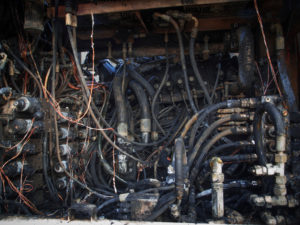Tag Archive: heavy machinery
-
Brian’s Areas of Expertise Include:
-
Heavy Machinery Fires Caused by Hydraulic Hose Failures
Leave a CommentHeavy machinery fires are often caused by hydraulic hose failures. Pressurized hydraulic fluid escaping from a failed hose assembly can be atomized into a fine spray that can be ignited by heated engine surfaces such as the engine exhaust or turbocharger.
Hydraulic hoses often fail due to age and wear, requiring regular inspection and replacement of hydraulic hoses to prevent failures. Hoses may also fail if they are misrouted. Misrouting can lead to the hose being pinched or causing it to chafe against a sharp metal surface. (more…)
-
Case Study: Fatality Servicing Unsupported Excavator Boom
Leave a CommentA mini-excavator at a job site developed a leak at a hydraulic fitting at the base of the cylinder that raises and lowers the boom. A subcontractor foreman at the site raised the boom to search for the leak. The foreman found and attempted to tighten the leaking fitting. When he did, the fitting separated from the base of the cylinder, releasing the hydraulic pressure that held the boom aloft. The boom fell and the bucket struck a nearby superintendent for the general contractor.
-
Crawler Crane Calamity at Cement Plant
Leave a CommentA production building was being constructed at a cement plant. A large crawler crane was being used to install the pre-assembled metal wall framing of the building. The weights and lift radii of the four wall framing sections, along with the rigging spreader and other lift equipment, were within the rated capacity of the crane. (more…)
-
Crane Pile Driving: Who Owns This Loss?
Leave a CommentThe boom of a hydraulic crane was bent while removing temporary sheet piles at a construction site. A vibratory hammer had been placed at the top of the sheet piles to both drive and remove the piles. The vibratory pile driving placed no significant loads on the crane boom, as that operation relied on the weight of the sheet piles and the vibration of the hammer to sink the piles into the soil. The vibration of the hammer and the lifting force of the crane boom were needed to remove the sheet piles from the soil. (more…)
-
Mobile Crane Ground Support
Leave a CommentMobile cranes depend on stability through their outriggers. These are the four “legs” that are deployed onto soil or other working surfaces adjacent to the crane. When a mobile crane is set up at a site, the outriggers are deployed by a hydraulic mechanism that extends the four outriggers beyond the crane body and then jack the crane free of its wheels so that it is supported by the outriggers only. (more…)
-
Concrete Core Drill – Reducing Hazard Exposure by Design
Leave a CommentThe safety hierarchy is a well-established principle among safety professionals. It’s a reliable and widely accepted method to minimize or eliminate exposure to hazards in products and workplaces.
(more…) -
Crane Balancing Act
1 CommentThe operation of many cranes is a balancing act — one very similar to the childhood experience of using a playground seesaw. When the equipment isn’t properly balanced, the crane may succumb to the tipping force and fall to one side. Such a tipover is more common in mobile cranes rather than fixed-tower cranes.
(more…)

Type ofLoss
Not sure what you're looking for?
Browse All


